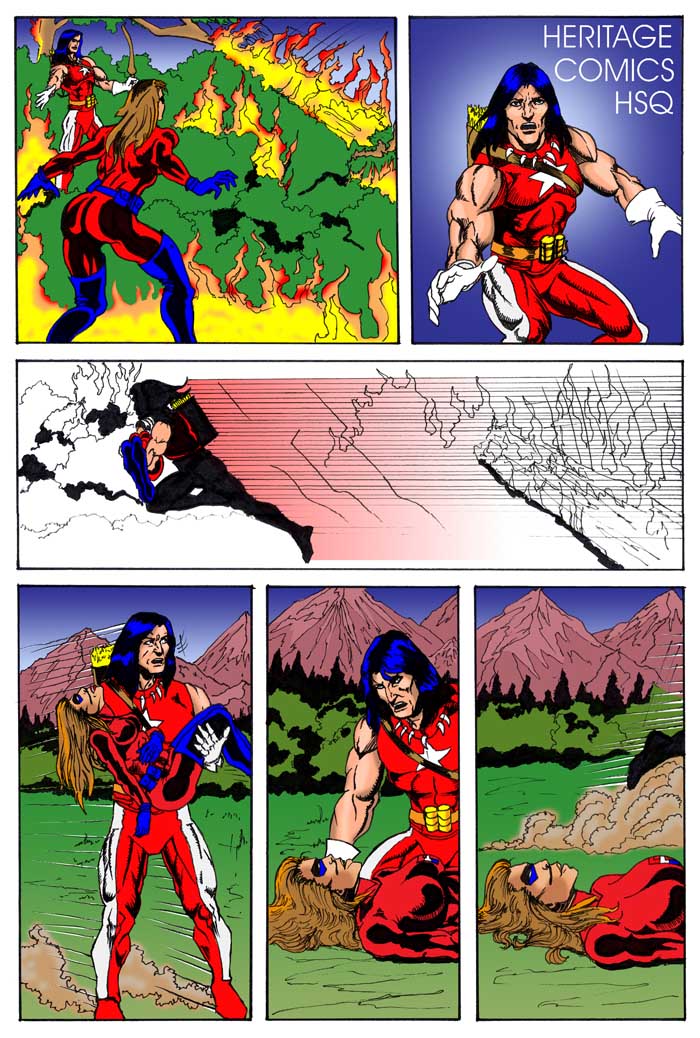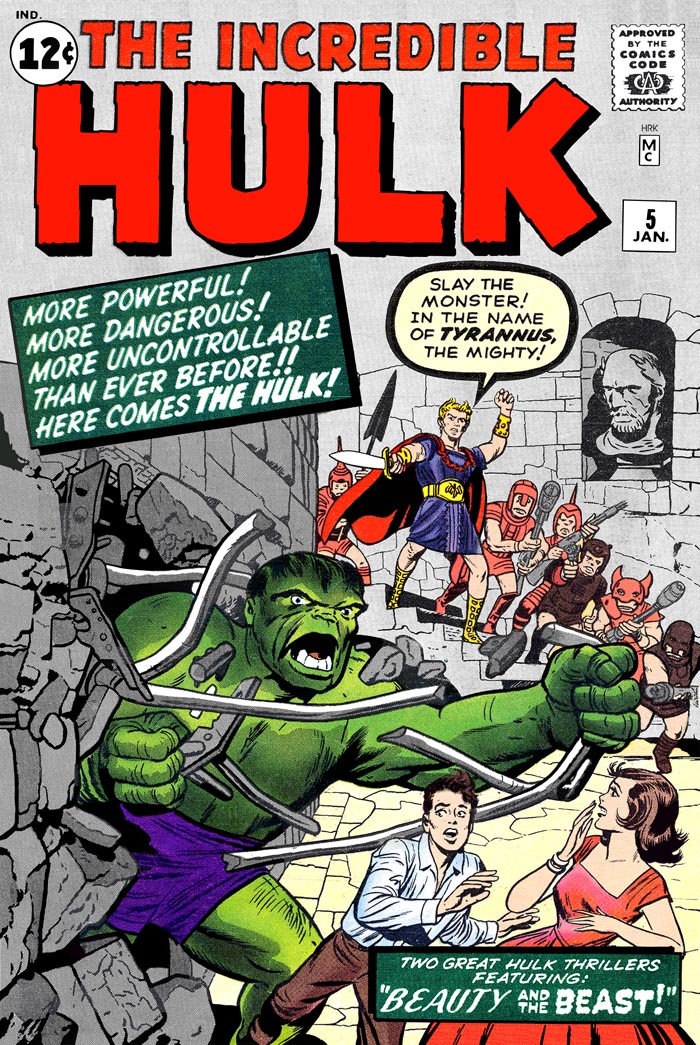In the late-50's/early 60's, Marvel's specialties were teen humor books, westerns, and "giant monsters". With the success of
THE FANTASTIC FOUR (which can easily be viewed as a combination of superheroes, giant monsters, and teen humor), publisher Martin Goodman was no doubt anxious to try for another hit. Taking the wild concept of
The Thing (in
F.F.) one step further,
Jack Kirby came up with
THE INCREDIBLE HULK. Instead of an angry "monster" being just one member of a team, this time, he's the star. And while test pilot Ben Grimm's volatile personality had its ups and downs, nuclear research scientist Bruce Banner found himself in a "
Dr. Jekyll & Mr. Hyde" situation. Changing back-and-forth between mild-manner intellect and wild, destructive, almost completely out-of-control unstoppable engine of destruction, it's no wonder it took years before anyone found out they were the same guy!
In addition,
Kirby has gone on record as saying he conceived
The Hulk as "a handsome Frankenstein". And who didn't watch the early
Boris Karloff movies half-wishing the monster would somehow, against all odds, come out on top and be viewed as a hero? Further, elements from several
1950's science-fiction movies found their way into the mix, particularly
THE AMAZING COLOSSAL MAN (where a man is caught in the blast of a nuclear explosion, somehow survives, but turns into a monster in the process), and
EARTH VS. THE FLYING SAUCERS (check out some of the characters in the film for parallels, especially the military types, the scientist, etc.). And then of course, there's the ever-present Cold War "
red scare".
(8-17-2013) I just dug out the files for these and have done
ADDITIONAL clean-ups. So if you've come here before, these are going to
look BETTER than they did before! (Pass it on...)
THE INCREDIBLE HULK 1 / art by Jack Kirby & Paul Reinman (May 1962)
While the first issue remains a powerful, exciting, and FUN read,
somehow
Kirby & his editor kept playing with the format, as if they weren't
sure or weren't satisfied with exactly how to handle the characters and
concept. But taken as a whole, it's a wild ride.
THE INCREDIBLE HULK 2 / art by Jack Kirby & Steve Ditko (July 1962)
THE INCREDIBLE HULK 3 /
art by Jack Kirby & Dick Ayers (September 1962)
THE INCREDIBLE HULK 4 / art by Jack Kirby & Dick Ayers (November 1962)
THE INCREDIBLE HULK 5 / art by Jack Kirby & Dick Ayers (January 1963)
After
5 issues,
The Hulk became one of the first Marvel characters of the
1960's to cross over with another book, when he guest-starred in
FANTASTIC FOUR #12.
Things were kept very consistent because the same
3 guys were handling
both books at the time--
Jack Kirby, his editor, and
Dick Ayers.
FANTASTIC FOUR 12 / art by Jack Kirby & Dick Ayers (March 1963)
A difference of opinion on the contents for the
6th
issue resulted in
Kirby apparently TEARING several pages of pencilled
art IN HALF, and quitting the book on the spot. Perhaps his editor was the one
who kept changing his mind on the book's direction, and
Kirby had had
enough, especially if changes were requested AFTER several pages had
already been done? In his place,
Steve Ditko was recruited, who'd already inked the cover and interior of issue
#2. Just
7 months earlier,
Ditko had illustrated the debut of
Spider-Man in
AMAZING FANTASY #15, and the same month he did
HULK #6,
AMAZING SPIDER-MAN #1 appeared!
4 months later, the
1st installment of
Ditko's own creation,
Dr. Strange, would debut in
STRANGE TALES #110.
THE INCREDIBLE HULK 6 / art by STEVE DITKO (March 1963)
With the departure of
Kirby, it was decided to cancel
THE HULK after
6 issues, in favor of other projects. But he would not be out of the spotlight for long. Only
6 months later, he'd return, in the
1st issue of what today might be called a "company-wide crossover"--
THE AVENGERS. And, eventually, he got his own series again, the
2nd time in the pages of
TALES TO ASTONISH.
Finally, as a extra treat... many comics fans are not aware that artists, even those with "cartoony" styles, often base their creations on REAL people. It's even more hidden when they're followed over the years by an army of other illustrators, who are not aware of the original models, or simply fail to stay "on model", and compounded by decades going by and later generations of fans who simply have no knowledge of the people who served as inspiration, or even of the original creators themselves.
With this in mind, I've been slowly trying to track down the people I believe many of these characters were based on. In the case of this series, I've managed to find the following...
BRUCE BANNER (Burt Lancaster)
GENERAL "THUNDERBOLT" ROSS (Thorley Walters)
BETTY ROSS (Donna Reed)
RICK JONES (Robert Walker Jr.)
MAJOR GLENN TALBOT (Lee Van Cleef)
I just discovered
Betty Ross the other day, after re-reading
HULK #2 and flipping again thru
HULK #1. In some panels, she was so similar, it was downright spooky! Imagine my delight when I was able, very quickly, to find a photo where she even had the same HAIR as
Jack Kirby had drawn in
HULK #1.
Rick Jones I mostly noticed from his appearance in
TALES OF SUSPENSE, while
Glenn Talbot came from his
1st appearance.
Kirby never drew him quite like this, because
Talbot was created by
Steve Ditko!
I remember, when I was re-reading this story in
TALES TO ASTONISH #61 a few years ago, seeing the above panel, and thinking,
"Oh my GOD!! it's LEE VAN CLEEF!!" Ever since, I can hear his voice in my head when I read
Talbot's dialogue. He never quite looked this recognizable afterwards, and when
Jack Kirby returned several issues later
Talbot became a more "generic" character.
The last one I added here was actually
Bruce Banner. This suggestion was courtesy of
Christian Alexis Olmeda, over at the
Jack Kirby Fan Group (before that group went to HELL). It wasn't one that I might have ever thought of myself, as I tend to see
Burt Lancaster in "action" roles, but then I found this photo from
1957, and whatta ya know? That IS pretty close to what
Kirby drew in
HULK #1.
(Continued in
Tales To Astonish, Part 4)
Artwork (C) Marvel Comics
Raw Scans supplied by Barry Pearl
Restorations by Henry R. Kujawa


































































